In 2006, the French regulator awarded WiMAX licences to consortiums of operators
with the clear objective of providing broadband Internet access to homes that are
located too far from telephone exchanges to benefit from ADSL. Early in 2007, the
first WiMAX network was launched in the small Department of Loiret, while in Brittany
the regional authority announced that it will invest EUR128 million, helped by European
Community funds, to provide broadband access to 100% of homes in Brittany by 2013.
This project is likely to make further use of WiMAX technology.
We show in this article that the business model for delivering Internet access services
to low-population areas (‘white zones’) with WiMAX can be easily evaluated using
a simple STEM model which illustrates a greater network utilisation in isolated
towns than in rural areas.
Evaluating the business model for delivering services to white zones
In the model, white zones are defined as areas with a low population density (30
pop/km2) and a minimal number of inhabitants (1000 inhabitants). They do not include
areas that are almost totally empty of inhabitants, since it can be assumed that
operators will never target these for broadband coverage. The selection of such
areas is performed with MapInfo using French data from INSEE (see below).
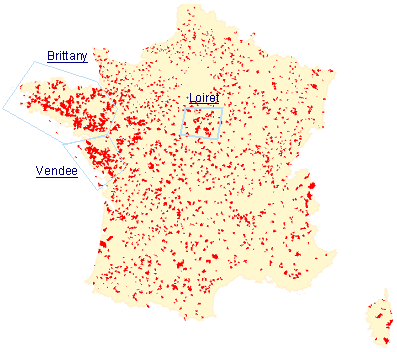
In Brittany and Vendee, we found that broadband white zones represent around 440
‘communes’ (town-level administrative areas) and 1 million people (about 415 000
households).
As shown below, the model structure has been kept very simple to demonstrate the
ability of the tool to obtain significant results quickly.
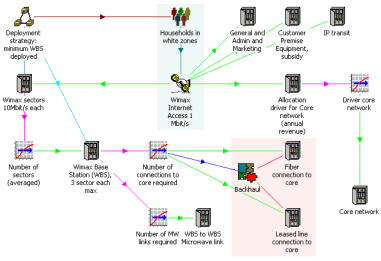
The coverage of the WiMAX infrastructure will affect the addressable market. This
is modelled here by using a Location element and linking the size of the Market
Segment to the proportion of WiMAX base stations (WBS) deployed to date.

Initially, the backhaul connecting base stations to the core network is leased,
and later fibre connections are built to a proportion of the base stations, using
a Function to model the migration path. To keep the model simple, the core network
is assumed to be leased from another operator, for a flat fee. Here we use a “dummy”
Resource to capture responsibility for a share of the core network cost (on the
basis of service revenue), and a Transformation to drive the fixed annual cost.
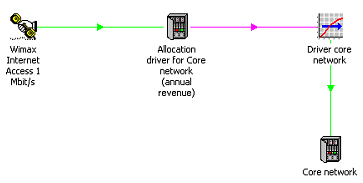
Comparing strategies for isolated towns and rural areas
To increase the granularity of the analysis, the model takes into account two types
of white zones: isolated towns (with significant population but spread over a large
area, making DSL a less efficient access network) and rural areas (with a lower
number of households). These are modelled easily using a Template that duplicates
the portion of the model which varies between the two geo-types.
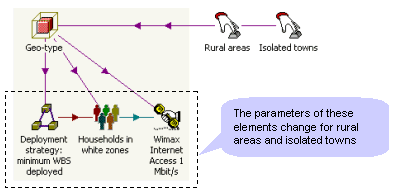
Note: Because the service icon is replicated, the core network cost is separately
allocated between isolated towns and rural areas on the basis of the revenue for
each service.
The initial deployment of infrastructure is driven simply by coverage requirements.
The model shows that, for isolated town only, further demand drives the installation
of additional sectors and later additional WiMAX base stations. In rural areas,
the fact that there remains slack capacity shows that the infrastructure does not
need to be upgraded.
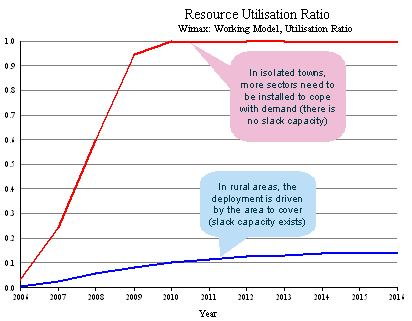
The model also shows that the EBITDA will only become positive after the deployment
is complete (5 years in our model) and when penetration reaches a sufficient level
(30% of covered households in our model).
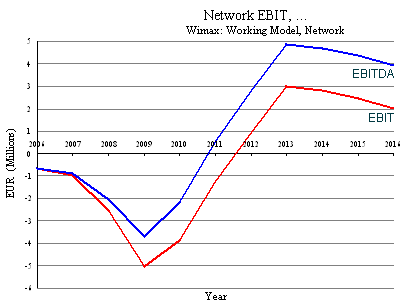
A profitable business model remains a challenge, as the discounted future revenues
are not high enough to make the early investment in network infrastructure financially
worthwhile. However, an entity such as a public investment body that has a strong
interest in rural development may find WiMAX an adequate technology to offer broadband
Internet access service to households in white zones, and might be prepared to provide
sufficient financial support to make the business model for the operator viable.
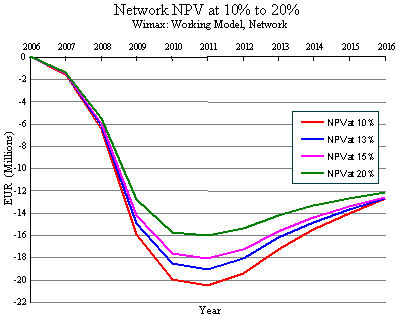
Conclusion
A simple STEM model has been built to illustrate the recent strategies of WiMAX
operators in France’s Brittany region. The model shows that EBIT will become positive
once a sufficient number of households subscribe to the service. A profitable business
model remains, however, a challenge as significant investment is necessary to cover
such sparsely populated areas.